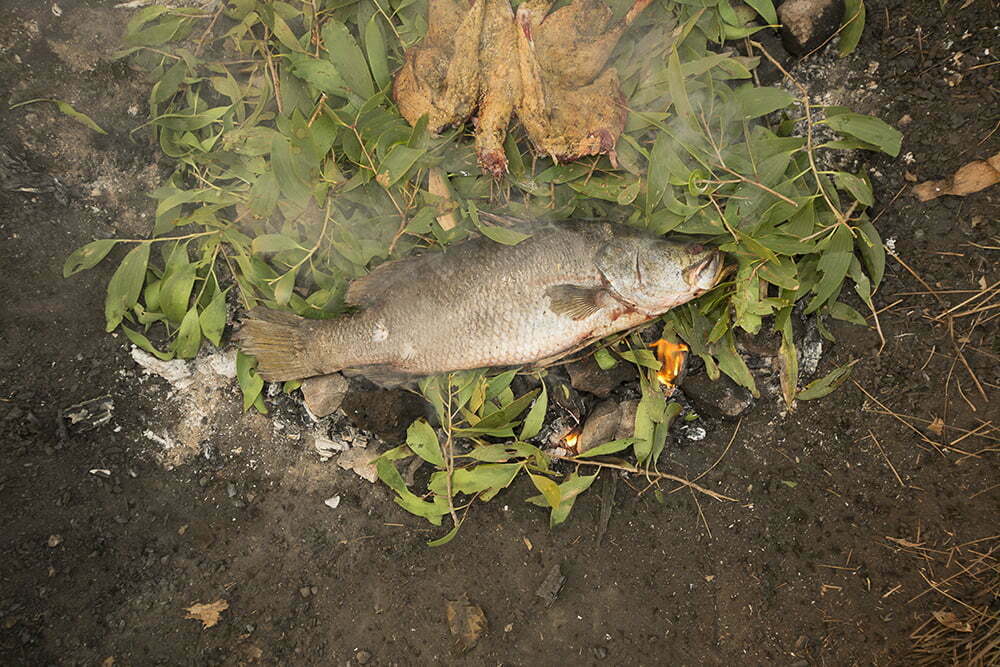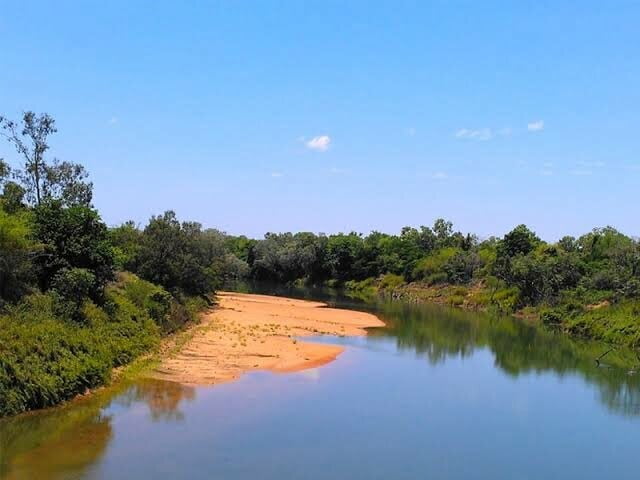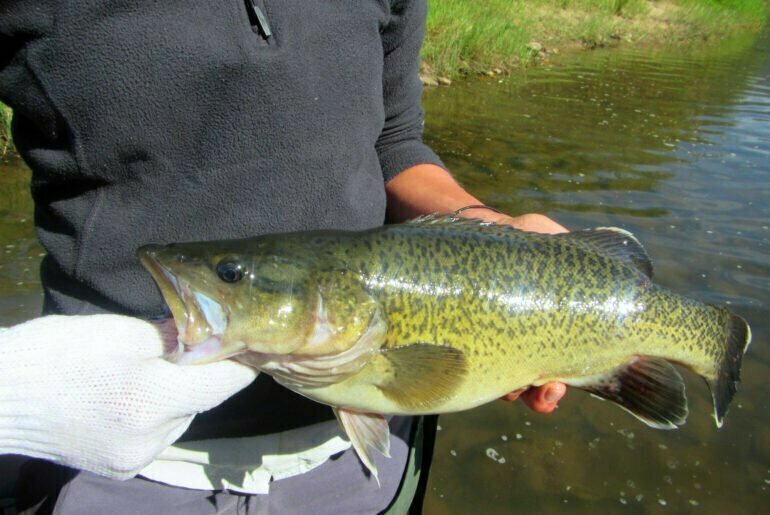Australia’s tropical rivers account for about 50 per cent of the country’s freshwater resources and hold an amazing diversity of aquatic fauna and flora. Governments have a strong vision for future development in northern Australia, particularly for the expansion of irrigated agriculture. The ecological impacts of changes to river flows are, however, poorly understood in the region. Making decisions involving trade-offs between the water needs of communities, the environment and future industries is made even more challenging without this knowledge.
The need to understand how our river systems work is particularly pressing in the Daly River catchment in the Northern Territory. Most of the Northern Territory’s current irrigation activity occurs in the Daly, and its reliable groundwater reserves and relatively good soils make it a prime candidate for further agricultural development. The amount of water within a river, particularly during the dry season, as well as the timing of flow pulses in the wet season, are important for supporting healthy rivers and the fish within them. The freshwater fish of northern Australia are of high recreational, economic and cultural importance. Filling some of the critical ecological knowledge-gaps, such as the distribution, habitat and movement needs and breeding cycles of these fishes is key to understanding and maintaining their water requirements.
Keeping tabs on fish populations
In 2006, a team of researchers from Charles Darwin University, Griffith University, Northern Territory Government and Traditional Owners, began investigating the ecological requirements of fish in the Daly River catchment. The project was part of the Daly River Fish and Flows Research Program. Aboriginal Traditional Owners have been a central part of the project; assisting with field sampling and providing valuable Indigenous knowledge on fish ecology, as well as their cultural significance.

Sampling initially occurred at 55 sites throughout the catchment, and has been ongoing in eight main channel sites from near Katherine township, and downstream to near Nauiyu in the lower reaches of the Daly River. Led by Michael Douglas along with Mark Kennard, Brad Pusey and Sue Jackson, the project became a flagship activity for the Tropical Rivers and Coastal Knowledge program (TRaCK). It has continued under the Australian Government’s National Environmental Research Program as part of the research on river connectivity (with Alison King joining the project team). This year the project team is entering its 10th year of sampling, making it one of the longest running assessments of freshwater fishes in northern Australia. Adjunct Associate Professor Brad Pusey says the data is continuing to shed light on the distribution, abundance, habitat use, and influence of river flows on fish in the River.
This is a highly diverse area for freshwater fish, with nearly 100 species of fish recorded in the Daly. We have collected species from a wide variety of taxonomic groups, from a diversity of habitat types, and reproductive and feeding strategies. The fish assemblage changes throughout the catchment. The location in the catchment, distance from river mouth, flow permanence and habitat structure are all important determinants of the fish assemblage, he said.
Principal Research Fellow Alison King says catches of most species vary considerably between sites, among years and among sampling occasions.
Barramundi are an important recreational and cultural fish species for the region and are regularly caught at all of our main channel sites throughout the catchment, she said.
The surveys have also provided insight into the impact and recovery from natural catastrophic fish kill events in tropical rivers. In October 2012 a blackwater event, which occurs when large amounts of organic material removes oxygen from the water, caused a substantial fish kill at Galloping Jacks on the Katherine River. The impact of the event varied across species.
There was an obvious decline in catch of some species such as juvenile sooty grunter immediately after the fish kill, but numbers soon increased. Numbers of some small-bodied species, such as strawmen and rainbowfish, appeared to increase straight after the event. Whereas, freshwater sole, which were regularly recorded at the site prior to the fish kill, haven’t been recorded since, said Alison.
Predicting the impact of future development
The river and its catchment are in relatively good environmental condition compared to many other major rivers in Australia. Principal Research Fellow Dr Mark Kennard warns, however, that current and future development, particularly around water use, could start to impact on the health of the river and its fish. For example, groundwater extraction from bores for agriculture will reduce dry season river flows.
Preliminary risk assessments identified several fish species at high risk from dry season groundwater water extraction, including large‐bodied fish of cultural and recreational importance, such as black bream and barramundi, as well as less iconic, but nevertheless ecologically important smaller-bodied species, he said.
Researchers used more complex modelling involving a mixture of primary data, scientific knowledge and Indigenous knowledge to predict the effect of dry season water extraction scenarios on barramundi and sooty grunter populations.
The modelling predicted that both barramundi and sooty grunter populations would be impacted by lower flows. For sooty grunter, the juveniles appear to rely on shallow, riffle habitats as a nursery area, which are vulnerable to reduced flows. Barramundi, on the other hand, were particularly impacted by the timing of water extraction, with greater impact occurring in with late dry season extraction. The abundance of adult barramundi increased with increasing magnitude of recent wet season flows, whereas juvenile barramundi decreased, Mark said.

The study has also shed light on the importance of river connectivity for these fish; with nearly half requiring access to the estuary or ocean to breed. This finding has obvious implications for potential barriers to movement such as instream structures, road crossings, levees or low flows.
Moving forward
Much progress has been made in understanding the distribution, abundance patterns and flow-related ecology of fishes within the Daly River. While data collection is continuing, further research is now underway to quantify the importance of river flows on the distribution and abundance of fish in the main channel.
With nearly ten years of survey data, we’re now analysing the data to predict with more certainty how wet season and dry season flows influence fish populations in the Daly River, said Alison.
Professor Michael Douglas says the long-term project continues to provide foundation science and knowledge about fish in the Daly River for the management of its water resources and aquatic ecosystem and preservation of its environmental values.
The project’s findings can contribute to water resource management by the Northern Territory Government to avoid the over-allocation of water resources, which have caused so many problems for rivers in southern Australia, as well as the broader development of the catchment, notably for the river’s floodplains which are vital habitats for many fish, he said.
Indigenous Knowledge

While the scientific community still have more to learn about the ecological requirements in the Daly River, there is already an established Indigenous knowledge base that has accrued over generations for the purpose of hunting fish for food. The catchment is home to at least 10 Indigenous language groups, who own almost a third of the land. Two language groups in the middle and upper reaches of the region, Wagiman and Wardaman, provided input to the project on their existing knowledge, management actions and cultural responsibilities to sustain fish.
The researchers found much of the existing traditional knowledge was congruent with their own findings, and in some cases helped to extend their understanding of fish ecology. Traditional Owners were able to provide more knowledge about fish distributions within the river system, such as plentiful sightings of the snub-nosed garfish in the King River by Wardaman participants, which had only been collected by researchers on one occasion. Indigenous knowledge also supported scientific observations on habitat use. For example, Wagiman participants were able to confirm sightings of the giant gudgeon commonly occurring in billabong habitats.
The research partnership was also beneficial for the Indigenous participants. The field trips provided opportunities for storytelling and to pass on knowledge about fish and their cultural significance to younger generations. Senior Research Fellow Dr. Sue Jackson says cross cultural collaborations like these can contribute positively to water resource planning by generating shared understandings of management objectives and values.
They also improve regional capacity to evaluate and apply scientific and local knowledge to water use pressures, she said.
Related stories:
More great stories about fish and flows in the North can be found in the RipRap Magazine 38 – Northern Australia’s Rivers and Estuaries.



